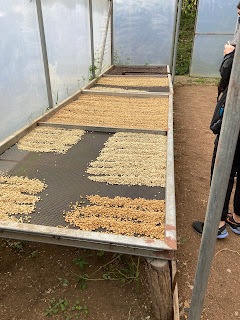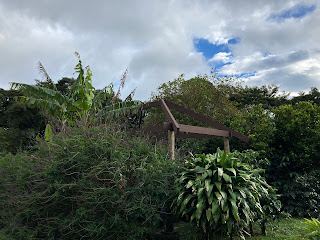As one of our outings in Costa Rica, we went to the Cafe Monteverde, a sustainably grown and managed coffee company. Founded in 1989 by a group of coffee growing families with several generations of growing experience, they now operate the plantation as a sustainability model as well a coffee growing operation.
But first, of course, we start with lunch! All of the items below for lunch and the dessert (cooked pumpkin with caramelized sugar cane sap) was all produced on site.
Corona, the coffee farm dog. Because all coffee farms need a dog.
Coffee, as you likely know, consists of two varieties: Coffea Arabica and Coffea "Robusta". Arabica is often considered to be the more desirable plant.
These are coffee seedlings from coffee beans. They will grow here for about a year.
After which, they are transplanted to the ground where they will grow for up to five years before being moved.
Once mature, they can live and produce from 15 to 30 years.
Part of the operation is working on sustainable methodologies for growing. Here are ongoing practices of "fermenting" fertilizer, along with the ingredients and their open air composting (next two pictures).
The actual bean itself grows directly on the plant, starting green and ending red. The season in Costa Rica runs from the End of November to April/May.
Green bean and fully ripe bean:
Coffee here is handpicked into baskets as it has been done for 100 years or more. Pickers are paid by the basket (interesting fact: Pickers are mostly from Nicaragua, as are a great many other agricultural operations. Pickers here are paid $2.00 a basket; they would make $0.70 a basked in Nicaragua).
The Supervisor. Because you always need a supervisor:
After picking, the outer layer of bean is dehusked. Below is a small scale unit that is hand operated; the farm has a much larger industrial version down the mountain.
Here at Cafe Monteverde, coffee is then dried three ways: the first is with two layers of husk/skin removed, the second with one layer removed, and third with the beans unhusked.
The final step is, of course, roasting.
Two small roasters are on site (again, there are larger units in another location). Fun fact: The difference between a light and dark roast are within the last five minutes of the roasting process. When asked how a master roaster knows when a batch is ready, the answer was a combination of experience, smell, and just "knowing". (Another fun fact: Starbucks tastes burnt for a reason. To cover up substandard or mixed lots of beans, they will just give the darkest roast possible, which equalizes out the flavor).
We tasted a total of five coffees: all three drying processes, and two other roasts. Sadly (much like my wine abilities), I could not taste the difference.
Some shots from around the farm:
This was a high point of our trip for me as I like coffee and I believe in the sort of sustainable agriculture being practiced here. They ship world wide, so they are worth visiting on the InterWeb if you drink coffee: Cafe Monteverde

































What an interesting blog post. I've lamented that coffee plants are tropical and won't grow in my climate. Otherwise I'd grow them!
ReplyDeleteLooks like their fermented fertilizer is a kind of compost tea. I'm guessing that the hoses going to the bottles on top of the barrels is an air lock system with water in the bottles. Very clever! I love simple technology.
Leigh this pleases me ever so much as (to be honest) I wrote the post with you in mind (as well "taking notes" during the tour, thinking "Leigh would love this"!). Sadly it will not grow in my Area of Operation either (either one), as we have neither volcanic soil nor regular tropical temperatures.
DeleteYou are exactly right on the air hoses to the air lock. To be honest, compost tea sounds right, although I think our guide explained it a little differently (to the same end, however).
The whole thing was fascinating, and really was one of the highlights of my tour.
Oh! You just made my day! Thank you so much. :) I'm always fascinated by other places and cultures, but the farming and agricultural practices are of special interest. There's always something to learn.
DeleteYou are welcome Leigh! I am glad you enjoyed reading it - I certainly learned a lot.
DeleteThe coffee portion of the trip would be lost on me. Don't drink it and it all smells burnt. But parents were big coffee drinkers and for Christmas one year I got them Coffee from Around the World. Every other month coffee would show up. Later that year they informed me to please don't gift that to them again as they liked their Folgers best and wasn't crazy about any of what the world had to offer.
ReplyDeleteMargi
Margi - This reminds me of TB The Elder when we would visit him - he, too, preferred Folger's to anything we would purchase and bring with us. I keep a can of it at The Ranch now in honor of him.
DeleteMy palate is not sophisticated enough to taste the differences. I do like my cup in the morning, though.
The actual plantation/processing part was fascinating. I enjoy seeing how these sorts of things are done.
I grew up hating the smell of my parent's coffee in the morning.
DeleteI found myself at age 20 working on a mountaintop in Italy and staying in a hotel there with little heat.
In the morning, everyone was having coffee at the bar to warm up.
An Italian engineer I worked for told me to have some cappuccino. That was my entry drug.
Soon, I was sipping espresso and then Turkish coffee in Turkey.
All because of the Arab Oil Embargo.
Ed, Turkish coffee - and Greek coffee - are among my favorites. I should learn how to make them.
DeleteI, too, grew up not liking coffee. I do not think I really picked up the habit until I had graduated from college.
Yup. That's why you have to hide the coffee flavor from Starbucks. Folgers is better.
ReplyDeleteJohn, I had no idea prior to this tour. But it all makes sense. Maximize profits, minimize effort. And serve bad coffee.
Delete(Although, to be fair, their Green Tea Frappuccinos are both delicious and terrible for me.
Best coffee I've ever had is "Mushers Blend" from the North Pole Coffee Company in Alaska. Wasn't that expensive, either.
DeleteMy all time favorite is Cafe Du Monde Coffee and Chicory from New Orleans, which is not everyone's favorite - but it does come in that handy steel can, which is infinitely useful as well (and is still painted on, not a plastic wrap like so many other coffee companies).
DeleteI am a hopeless coffee wreck. We are currently drinking a New Mexican roasted coffee with Pinon. I think it is great. We could have something tomorrow and again, I will think it is "great" in that it is hot and tastes like coffee.
We gathered Pinion nuts when I was a kid - they were actually more popular (locally) than sunflower seeds, though I never had it in coffee.
DeleteChicory? Not my thing.
I had only heard of them John. I have to say they make for a good roast (I even got a compliment from The Ravishing Mrs. TB, which does not often happen when I try some of my more experimental buys).
DeleteChicory is indeed an acquired taste. I am the only one here that likes it (unless it has a lot of milk, which I do not care for but which, I understand, the chicory/coffee mix is designed for).